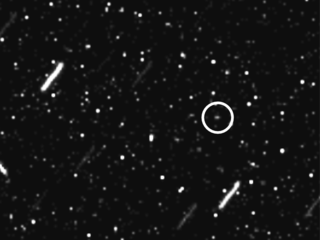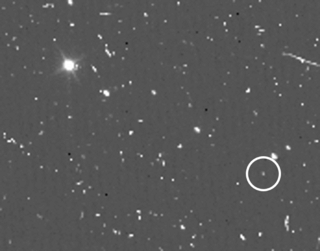Related Research Articles

Skathi, also named Saturn XXVII and originally spelled Skadi, is a natural satellite of the planet Saturn. Skathi is one of Saturn's irregular moons, in its Norse group of satellites. It was discovered on September 23, 2000, by a team of astronomers led by Brett Gladman. The team announced their discovery on December 7, 2000, along with seven other satellites of Saturn, namely; Tarvos, Ijiraq, Thrymr, Siarnaq, Mundilfari, Erriapus, and Suttungr. The moon was named after Skaði, a figure in Norse mythology, as part of an effort to diversify the largely Greek and Roman names of astronomical objects.
Scott Sander Sheppard is an American astronomer and a discoverer of numerous moons, comets and minor planets in the outer Solar System.
Fenrir, or Saturn XLI, is a natural satellite of Saturn. Its discovery was announced by Scott S. Sheppard, David C. Jewitt, Jan Kleyna, and Brian G. Marsden on May 4, 2005, from observations taken between December 13, 2004, and March 5, 2005. Fenrir has an apparent magnitude of 25, making it one of the faintest known moons in the Solar System, and was discovered using some of the largest telescopes in the world. It is even too dark to have been observed by the Cassini spacecraft when it was in orbit around Saturn, for which it never got brighter than approximately 17th apparent magnitude. Fenrir was named after Fenrisulfr, a giant wolf from Norse mythology, father of Hati and Skoll, son of Loki, destined to break its bonds for Ragnarök.

Fornjot or Saturn XLII is the outermost named moon of Saturn. Its discovery was announced by Scott S. Sheppard, David C. Jewitt, Jan Kleyna, and Brian G. Marsden on 4 May 2005 from observations taken between 12 December 2004, and 11 March 2005. It had the largest semi-major axis among all the known moons of Saturn until the recovery of Saturn LVIII in 2019.
Farbauti or Saturn XL is a natural satellite of Saturn. Its discovery was announced by Scott S. Sheppard, David C. Jewitt, Jan Kleyna, and Brian G. Marsden on May 4, 2005, from observations taken between December 12, 2004, and March 9, 2005.

The Norse group is a large group of retrograde irregular satellites of Saturn. Their semi-major axes range between 12 and 27 Gm, their inclinations between 136° and 178° and their eccentricities between 0.06 and 0.63. Unlike the Inuit and Gallic groups, the orbital parameters are widely dispersed and the group is likely to be composed from a number of subgroups with more homogeneous orbital and physical parameters. The International Astronomical Union (IAU) reserves names taken from Norse mythology for these moons. The exception is Phoebe, the largest, which was discovered long before the others.

Hyrrokkin or Saturn XLIV is a natural satellite of Saturn. Its discovery was announced by Scott S. Sheppard, David C. Jewitt, Jan Kleyna, and Brian G. Marsden on June 26, 2006, from observations taken between December 12, 2004, and April 30, 2006.

Greip or Saturn LI is a natural satellite of Saturn. Its discovery was announced by Scott S. Sheppard, David C. Jewitt, Jan Kleyna, and Brian G. Marsden on 26 June 2006, from observations taken between 5 January and 1 May 2006. Greip is about 5 kilometres in diameter, and orbits Saturn at an average distance of 18,066 Mm in 906.556 days, at an inclination of 172.7° to the ecliptic, in a retrograde direction and with an eccentricity of 0.3735, and is presumably at high risk of eventually colliding with Phoebe. It is unknown whether Greip is more similar to Suttungr or Hyrrokkin in color. Its rotation period is most likely 12.75±0.35 hours with two minima in the light curve, but a longer period of 19 hours cannot be ruled out due to the short observation time by Cassini–Huygens.
Jarnsaxa, also known as Saturn L, is a natural satellite of Saturn. Its discovery was announced by Scott S. Sheppard, David C. Jewitt, Jan Kleyna, and Brian G. Marsden on June 26, 2006, from observations taken between January 5 and April 29, 2006.
Surtur or Saturn XLVIII is a natural satellite of Saturn. Its discovery was announced by Scott S. Sheppard, David C. Jewitt, Jan Kleyna, and Brian G. Marsden on June 26, 2006 from observations taken between January and April 2006. It was named after Surt, a leader of the fire giants of Norse mythology.

Skoll or Saturn XLVII is a retrograde irregular satellite of Saturn. Its discovery was announced by Scott S. Sheppard, David C. Jewitt and Jan Kleyna on 26 June 2006 from observations taken between 5 January and 30 April 2006.
Gridr, originally known as S/2004 S 20, is a natural satellite of Saturn. Its discovery was announced by Scott S. Sheppard, David C. Jewitt, and Jan Kleyna on October 7, 2019 from observations taken between December 12, 2004 and March 22, 2007. It was given its permanent designation in June 2021. On 24 August 2022, it was officially named after Gríðr, a jötunn in Norse mythology. She is the mother of Víðarr the silent and the consort of Odin. She warned Thor about the treachery of Geirröðr and equipped him with her belt of strength, her iron glove, and her staff Gríðarvöl (Gríðr's-staff).
Angrboda, provisionally known as S/2004 S 22, is a natural satellite of Saturn. Its discovery was announced by Scott S. Sheppard, David C. Jewitt, and Jan Kleyna on October 7, 2019 from observations taken between December 12, 2004 and February 1, 2006. It was given its permanent designation in August 2021. On 24 August 2022, it was officially named after Angrboða, a jötunn in Norse mythology. She is the consort of Loki and the mother of the wolf Fenrir, the Midgard serpent Jörmungandr, and the ruler of the dead Hel.
Skrymir, provisionally known as S/2004 S 23, is a natural satellite of Saturn. Its discovery was announced by Scott S. Sheppard, David C. Jewitt, and Jan Kleyna on October 7, 2019 from observations taken between December 12, 2004 and March 22, 2007. It was given its permanent designation in August 2021. On 24 August 2022, it was officially named after Útgarða-Loki. He is a jötunn from Norse mythology and master of illusions.
Gerd, provisionally known as S/2004 S 25, is a natural satellite of Saturn. Its discovery was announced by Scott S. Sheppard, David C. Jewitt, and Jan Kleyna on October 7, 2019 from observations taken between December 12, 2004 and March 22, 2007. It was given its permanent designation in August 2021. On 24 August 2022, it was officially named after Gerðr, a jötunn from Norse mythology. She is married to Freyr and the personification of fertile soil.
Eggther, provisionally known as S/2004 S 27, is a natural satellite of Saturn. Its discovery was announced by Scott S. Sheppard, David C. Jewitt, and Jan Kleyna on October 7, 2019 from observations taken between December 12, 2004 and March 21, 2007. It was given its permanent designation in August 2021. On 24 August 2022, it was officially named after Eggþér, a jötunn from Norse mythology. He is the herder of the female jötunn who lives in Járnviðr (Ironwood) and raises monstrous wolves. In the poem Völuspá, Eggþér is described as sitting on a mound and joyfully striking his harp while the red rooster Fjalarr begins to crow to herald the onset of Ragnarök.
Beli, provisionally known as S/2004 S 30, is a natural satellite of Saturn. Its discovery was announced by Scott S. Sheppard, David C. Jewitt, and Jan Kleyna on October 7, 2019, from observations taken between December 12, 2004, and March 21, 2007. It was given its permanent designation in August 2021. On 24 August 2022, it was named after Beli, a jötunn from Norse mythology. He is killed by Freyr with the antler of a hart (stag). According to John Lindow, the myth of Beli is partially lost. Some scholars suggest that he may be the brother of Freyr's wife Gerðr, although this is uncertain.
Gunnlod, provisionally known as S/2004 S 32, is a natural satellite of Saturn. Its discovery was announced by Scott S. Sheppard, David C. Jewitt, and Jan Kleyna on October 8, 2019 from observations taken between December 12, 2004 and January 19, 2007. It was given its permanent designation in August 2021. On 24 August 2022, it was officially named after Gunnlǫð, a jötunn from Norse mythology. She is the daughter of Suttungr and guarded the mead of poetry for him. But Odin in the form of a snake gained access to the chamber in Hnitbjorg where the mead was kept, seduced Gunnlǫð, and slept with her for three nights. In return Gunnlǫð allowed Odin three drinks of the mead, and he then immediately flew out of the cavern in the form of an eagle.
Thiazzi, provisionally known as S/2004 S 33, is a natural satellite of Saturn. Its discovery was announced by Scott S. Sheppard, David C. Jewitt, and Jan Kleyna on October 8, 2019 from observations taken between December 12, 2004 and March 22, 2007. It was given its permanent designation in August 2021. On 24 August 2022, it was officially named after Þjazi, a jötunn from Norse mythology. He is a son of Alvaldi and kidnapped the goddess Iðunn, who guarded the apples of the gods.
Geirrod, provisionally known as S/2004 S 38, is a natural satellite of Saturn. Its discovery was announced by Scott S. Sheppard, David C. Jewitt, and Jan Kleyna on October 8, 2019 from observations taken between December 12, 2004 and March 22, 2007. It was given its permanent designation in August 2021. On 24 August 2022, it was officially named after Geirröðr, a jötunn from Norse mythology. He is an enemy of Thor and is killed by him.
References
- ↑ Discovery Circumstances from JPL
- 1 2 S.S. Sheppard (2019), Moons of Saturn, Carnegie Science, on line
- 1 2 "MPEC 2019-T157 : S/2004 S 35". minorplanetcenter.net. Retrieved 8 October 2019.
- ↑ "M.P.C. 133821" (PDF). Minor Planet Center. International Astronomical Union. 10 August 2021. Retrieved 21 August 2021.
- ↑ "Names Approved for 10 Small Satellites of Saturn". usgs.gov. USGS. 24 August 2022. Retrieved 30 August 2022.
- ↑ Simek, Rudolf (1996). Dictionary of Northern Mythology. D.S. Brewer. p. 99. ISBN 978-0-85991-513-7.
- ↑ Orchard, Andy (1997). Dictionary of Norse Myth and Legend. Cassell. p. 5. ISBN 978-0-304-34520-5.